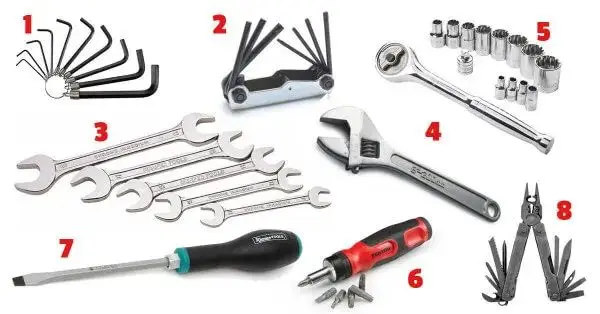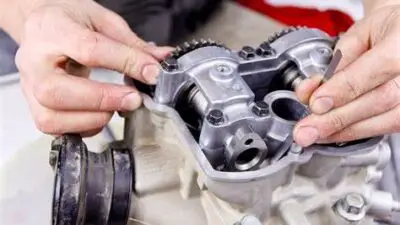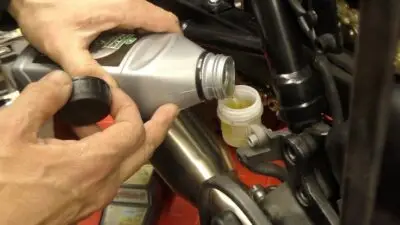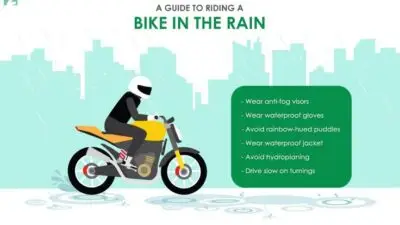Breaking down on the road with your motorcycle can be stressful, but having the right tools handy can turn a potential disaster into a minor inconvenience. A well-equipped motorcycle tool kit serves as your mechanical first aid kit, allowing you to handle common issues that might arise during your rides. Every rider should carry essential tools including a socket set, adjustable wrenches, screwdrivers, and tire repair items to address the most common roadside problems.

Whether you’re a weekend warrior or daily commuter, your toolkit doesn’t need to be complicated. Many manufacturers offer pre-made motorcycle tool kits designed specifically for your bike model, though you can also assemble a custom kit with basic garage essentials. The goal isn’t to carry an entire workshop but rather to have the crucial items that can help get you back on the road or safely to a repair shop.
Key Takeaways
- A basic motorcycle toolkit should include wrenches, sockets, screwdrivers, and tire repair essentials to handle common roadside emergencies.
- Quality tools stored in a compact carrying system like a tool roll ensure you’re prepared without adding excessive weight to your motorcycle.
- Regular practice with your tools at home improves your mechanical skills and confirms your kit contains everything needed for basic repairs.
Why Carry a Basic Motorcycle Tool Kit?
Every rider should be prepared for unexpected mechanical issues on the road. A well-equipped motorcycle tool kit serves as your first line of defense against breakdowns and can mean the difference between continuing your journey or being stranded.
Importance for Motorcycle Maintenance
Regular motorcycle maintenance is crucial for keeping a bike in optimal condition. Having the right tools on hand allows riders to perform basic maintenance tasks wherever they are.
A proper toolkit enables quick adjustments to chains, cables, and fasteners that may loosen during rides. These small fixes prevent minor issues from developing into major mechanical problems.
Many motorcycles require specific tools for maintenance tasks. Having these essential tools readily available ensures that routine maintenance isn’t delayed or overlooked.
DIY maintenance also helps riders develop a deeper understanding of their motorcycle’s mechanical components. This knowledge proves invaluable when diagnosing problems on the road.
Most importantly, consistent maintenance using proper tools extends the lifespan of the motorcycle and maintains its performance and reliability.
Peace of Mind During Rides
Carrying a basic tool kit provides significant psychological benefits for motorcyclists. Knowing they’re prepared for mechanical issues allows riders to focus on enjoying the journey rather than worrying about potential breakdowns.
This confidence is particularly important during long trips or when riding in remote areas where help may not be readily available. A well-stocked toolkit serves as insurance against being stranded.
Motorcycle tool kits don’t need to be extensive to be effective. Even a compact set with the right tools can handle most common roadside issues.
Many experienced riders customize their kits based on their specific motorcycle model and common problems they’ve encountered. This personalized approach ensures they’re prepared for the most likely scenarios.
Handling Emergencies on the Road
Mechanical emergencies can happen at any time, often in inconvenient locations. A basic toolkit empowers riders to address these situations immediately rather than waiting for professional assistance.
Common roadside emergencies include loose bolts, minor electrical issues, flat tires, or chain problems. Having the right tools means these issues can often be resolved in minutes rather than hours.
The ability to make temporary repairs can be crucial in remote areas where cell service is limited. A basic motorcycle toolkit might allow a rider to make it to the next town or service station.
Some motorcycle repairs require specific tools that may not be commonly available at general service stations. Carrying these specialized tools ensures riders can address model-specific issues.
Smart riders organize their tool kits for quick access to the most frequently needed items. This preparation reduces stress and frustration during roadside repairs.
Essential Hand Tools Every Biker Needs
A reliable set of hand tools is crucial for motorcycle maintenance and roadside repairs. Having the right tools can make the difference between a quick fix and being stranded.
Screwdrivers and Screwdriver Sets
Every motorcycle toolkit needs quality screwdrivers. A combination of flathead and Phillips screwdrivers in various sizes handles most motorcycle fasteners. Many bikes also require specialty bits.
Torx bits are increasingly common on modern motorcycles, especially European models. These star-shaped drivers prevent slippage during high-torque applications.
Hex keys (also called Allen keys) are essential for countless motorcycle components. A folding set saves space while providing multiple sizes. Look for sets with both metric and imperial measurements to cover all possibilities.
Consider investing in a multi-bit screwdriver with interchangeable tips. This space-saving option works well for roadside repairs without sacrificing functionality.
An impact driver helps with stubborn, seized screws that resist normal turning force. This tool converts hammer strikes into rotational force, freeing stuck fasteners without damaging them.
Wrenches: Spanner Set and Adjustable Wrench
A good set of combination wrenches (spanners) forms the backbone of motorcycle maintenance. These double-ended tools feature an open end and a box end in the same size.
Metric sizes are standard for most motorcycles, though some American and British bikes may require imperial wrenches. Essential sizes include 8mm, 10mm, 12mm, 14mm, and 17mm.
A quality adjustable wrench serves as backup when specific sizes are unavailable. Look for one with minimal play in the adjustment mechanism to prevent fastener damage.
Combination wrench sets can be found for under $50, making them affordable even for beginners. Chrome vanadium steel offers durability and rust resistance.
Consider wrenches with offset heads for better access in tight spaces. The angled design provides knuckle clearance when working around engine components.
Pliers and Vice Grips
A pair of needle-nose pliers handles small parts, wire routing, and reaching into narrow spaces. These versatile tools can retrieve dropped fasteners and manipulate small components.
Channel-lock pliers adjust to multiple sizes, making them ideal for odd-shaped objects and larger nuts. Their sliding joint accommodates various thicknesses.
Vice grips (locking pliers) function as temporary clamps, holding parts securely while working. They can also extract damaged fasteners when other methods fail.
Wire cutters help with electrical repairs, which are common roadside issues. Look for pliers with insulated handles for electrical safety.
A dedicated pair of snap-ring pliers makes removing circlips and retaining rings significantly easier. These specialized pliers prevent the rings from flying off dangerously during removal.
Socket Set and Socket Wrenches
A 3/8-inch drive socket set handles most motorcycle maintenance tasks efficiently. This versatile set should include both shallow and deep sockets in common sizes.
Ratchets speed up the process of removing multiple fasteners. A reversible mechanism allows for both tightening and loosening without removing the socket from the bolt.
Extensions reach fasteners in recessed areas that direct socket attachment can’t access. A set with 3-inch and 6-inch extensions covers most situations.
Consider a socket set with both metric and SAE sizes to accommodate all potential fasteners. Many bikes use a mix of standards, especially if they’ve been modified.
A torque wrench ensures proper tightening specifications, preventing damage from over-tightening. Critical components like engine cases and cylinder heads require precise torque values.
Universal joints allow access to bolts at awkward angles where straight tools won’t reach. These flexible connectors prove invaluable for complex motorcycle geometries.
Specialty Tools for Motorcycle Repairs
While basic hand tools can handle many tasks, certain motorcycle repairs require specialized equipment. These tools make complex repairs possible and help prevent damage to your bike during maintenance.
Torque Wrench and Spark Plug Socket
A torque wrench is essential for precise tightening of bolts and nuts. Motorcycle manufacturers specify exact torque values for critical components to prevent under or over-tightening, which can lead to parts failure or damage.
Digital torque wrenches offer the most accuracy, but beam-type or click-type wrenches are reliable alternatives at lower costs. When purchasing, look for one that covers 10-100 ft-lbs range for most motorcycle applications.
Spark plug sockets are designed specifically with rubber inserts that grip and protect ceramic spark plug bodies. They come in common sizes (14mm, 16mm, 18mm) depending on your motorcycle model. Using regular sockets risks cracking expensive spark plugs.
Always calibrate your torque wrench annually and never use it to loosen bolts, as this can affect its accuracy.
Chain Breaker and Riveter
For motorcycles with chain drives, a quality chain breaker and riveter are invaluable tools. Chain breakers push pins out of chain links to shorten chains or separate them for replacement.
A chain riveter properly secures master links when installing new chains. The tool applies even pressure to rivet the connecting link pins without damaging the chain. Look for models with multiple adapters to fit different chain sizes.
Professional-grade tools cost $80-150, but they’re worth the investment if you maintain your own bike. Budget options exist around $30-50 but may not last as long.
These tools eliminate the need for makeshift solutions that often damage chains and create safety hazards.
Tire Iron and Tire Repair Kit
Tire irons (also called tire spoons) are specialized levers for removing motorcycle tires from rims. Unlike car tire tools, motorcycle tire irons are thinner and shaped specifically for the tight beads of motorcycle tires.
A set of 3 tire irons of different lengths provides the leverage needed for most tire changes. Always use rim protectors to prevent scratching when using tire irons.
A complete tire repair kit should include:
- Tire plugs
- Insertion tool
- Reaming tool
- Pressure gauge
- Small air compressor
Tubeless tire repair kits allow riders to fix punctures without removing the tire from the rim. This capability is especially valuable during long trips where roadside assistance might be unavailable.
Tire Maintenance Essentials
Keeping your motorcycle tires in top condition is essential for safety and performance. Proper tire maintenance requires a few specialized tools that every rider should have in their toolkit.
Tire Pressure Gauge and Air Pump
A quality tire pressure gauge is one of the most important tools for motorcycle maintenance. Digital gauges provide accurate readings and are easy to read in all lighting conditions. Analog gauges are reliable alternatives that don’t require batteries.
The correct tire pressure affects handling, fuel efficiency, and tire wear. Riders should check pressure when tires are cold for the most accurate readings.
A portable air pump is essential for on-the-go adjustments. Look for compact models that can be powered by the motorcycle’s battery or have rechargeable batteries. Some premium pumps include preset pressure functions that automatically stop when the desired PSI is reached.
Recommended specifications:
- Pressure gauge accuracy: ±1 PSI
- Measurement range: 0-60 PSI
- Digital display with backlight (for digital models)
Compressor and Paddock Stands
A small electric compressor makes tire maintenance much easier at home. Unlike manual pumps, compressors work quickly and require minimal effort from the rider.
Paddock stands elevate the motorcycle for easier maintenance. Front paddock stands typically lift the bike by the steering stem or fork tubes.
These stands provide stability when working on tires or other components. Quality stands should be made from strong steel tubing with non-slip rubber feet.
When selecting a compressor, consider:
- Maximum PSI (should exceed 50 PSI)
- Noise level (under 80 dB is preferable)
- Duty cycle (longer is better for multiple tires)
- Power source compatibility (AC outlet or DC car/motorcycle adapter)
Rear Stand for Wheel Removal
A sturdy rear stand is crucial for removing the back wheel for tire changes or chain maintenance. Most rear stands lift the motorcycle by supporting the swingarm.
For sport bikes, look for stands with L-shaped arms that fit into spools mounted on the swingarm. Cruisers and standards often require stands that lift from under the swingarm or axle.
Proper wheel removal requires a stable platform. The rear stand should be rated to hold at least 1.5 times the weight of the motorcycle.
Key features to look for:
- Heavy-duty steel construction
- Rubber-coated contact points to prevent scratching
- Wide base for stability
- Smooth-rolling casters for easy positioning
- Adjustable width to fit different motorcycles
Electrical Tools and Accessories
Electrical problems can leave you stranded on the road if you’re not prepared. Having the right electrical tools in your motorcycle toolkit helps you diagnose and fix common issues quickly.
Multimeter and Spare Fuses
A multimeter is essential for diagnosing electrical problems on your motorcycle. This versatile tool measures voltage, resistance, and continuity to help identify issues with your bike’s electrical system. When choosing a multimeter, riders should opt for a compact, durable model that can withstand vibration.
Carrying spare fuses of various amperages matching your motorcycle’s specifications is crucial. Most motorcycles use blade-type fuses ranging from 5 to 30 amps.
Pro tip: Keep fuses in a small waterproof container and label them by amperage for quick identification. A blown fuse can cause total electrical failure, but having spares allows for a quick roadside repair.
Always check your owner’s manual to identify the correct fuse locations and ratings specific to your motorcycle model.
Electrical Tape and Duct Tape
Electrical tape is invaluable for temporary wire repairs and insulation. It prevents shorts and electrical fires when wires become damaged. High-quality electrical tape should be resistant to heat, moisture, and UV exposure.
Duct tape serves as a versatile backup for various emergency repairs beyond electrical issues. Its waterproof properties and strong adhesion make it perfect for:
- Temporarily securing loose parts
- Patching torn seats or fairings
- Creating waterproof seals around connections
A small roll of each tape type takes minimal space in a toolkit but can make the difference between continuing a ride or being stranded.
Zip Ties and Cable Ties
Zip ties and cable ties are lightweight, inexpensive items that can solve numerous problems on the road. These versatile fasteners can secure loose wires, fairing pieces, or other components that might vibrate loose during rides.
Recommended zip tie kit:
- Assorted sizes (4″, 8″, 12″)
- UV-resistant materials
- Different colors for easy identification
- Releasable options for temporary fixes
Riders should store zip ties in a small plastic bag within their toolkit. For maximum versatility, include both standard and heavy-duty ties capable of withstanding engine heat and road vibration.
Consider carrying zip ties with mounting holes that can be attached to existing bolts for more permanent fixes when combined with electrical tape.
Fluids, Lubricants, and Chemical Essentials
Keeping your motorcycle running smoothly requires the right fluids and lubricants. These products prevent friction, protect against rust, and make maintenance tasks much easier.
WD-40 and Grease
WD-40 is a versatile product that belongs in every motorcycle toolkit. It displaces moisture, loosens stuck parts, and provides light lubrication for various components. Keep a small can in your toolkit for emergencies and a larger one in your garage.
For longer-lasting protection, quality motorcycle grease is essential. Use waterproof lithium grease for bearings, pivot points, and threaded components. Apply it to:
- Steering head bearings
- Wheel bearings
- Kickstand pivots
- Bolt threads during reassembly
Remember that WD-40 is not a permanent lubricant. While it works well for freeing stuck bolts and temporary protection, proper chain lubricant provides better long-term protection than WD-40 for drivetrain components.
Oil Catch Pan for DIY Maintenance
A quality oil catch pan makes oil changes cleaner and more environmentally responsible. Look for models with:
- At least 4-quart capacity
- Anti-splash design
- Pour spout for easy transfer to recycling containers
- Wide opening to catch oil without spills
The Capri Tools Portable Oil Drain Pan or LubriMatic Professional Grade Oil Tray are excellent options that help make oil changes manageable. A good drain pan prevents messy spills and makes proper disposal easier.
When performing oil changes, position the pan directly under the drain plug before loosening it. This catches all oil and prevents environmental contamination.
Cable Luber for Controls
A cable luber is a specialized tool that helps maintain your motorcycle’s throttle, clutch, and brake cables. This simple device clamps around cables and allows lubricant to flow inside the cable housing.
Regular cable lubrication:
- Reduces friction and operating effort
- Prevents cable binding and breakage
- Extends the life of control cables
- Improves throttle and clutch response
Apply cable lubricant every 3-6 months or whenever controls feel stiff. The process takes just minutes but significantly improves your bike’s responsiveness and control feel.
When using a cable luber, select a lubricant specifically designed for motorcycle control cables rather than all-purpose products. This ensures proper viscosity and long-lasting protection against moisture and corrosion.
Storage Solutions for Motorcycle Tools
Organizing your motorcycle tools properly ensures quick access during maintenance or emergencies. The right storage solution protects your tools and makes them easy to find when needed.
Tool Roll and Storage Bags
A tool roll is one of the most practical storage options for motorcyclists. These compact, foldable pouches keep tools secure while taking minimal space on your bike. Most tool rolls feature individual pockets of various sizes to accommodate different tools and prevent them from damaging each other.
When selecting a tool roll, look for durable materials like heavy canvas or ballistic nylon that can withstand vibration and weather. Many quality rolls include tie-downs or straps to keep the bundle tight and secure.
For more extensive storage needs, dedicated motorcycle tool kits often come in their own storage bags with compartments for organization. These bags typically feature water-resistant materials and reinforced stitching.
Wall-mounted storage systems like pegboards offer an excellent garage solution, keeping tools visible and accessible. For home mechanics, magnetic tool holders can keep frequently used items within easy reach.
Safety Equipment for Maintenance
Working on your motorcycle requires proper protection to prevent injuries during maintenance tasks. The right safety gear keeps you safe while allowing comfortable access to your bike’s components.
Eye Protection and Gloves
Mechanic gloves are essential for protecting your hands from cuts, scrapes, and chemical exposure when working on your motorcycle. Choose gloves with reinforced palms and fingers that still offer good dexterity for handling small parts.
Safety glasses provide crucial eye protection when performing maintenance tasks. Debris, metal shavings, and fluids can easily splash or fly toward your face during repairs. Select glasses with side shields for complete protection.
For tasks involving chemicals like brake fluid or engine degreaser, consider using nitrile gloves rather than cloth ones. Nitrile provides better chemical resistance and prevents skin irritation.
Eye protection should be impact-resistant and meet ANSI Z87.1 standards. Clear lenses work best for indoor maintenance, while tinted options help when working outdoors.
Keep these safety items stored with your motorcycle toolkit for easy access during routine maintenance sessions.
Reference Materials and Manuals
Documentation is the foundation of effective motorcycle maintenance. Having the right reference materials ensures you can tackle repairs with confidence and avoid costly mistakes.
Service Manual and Repair Guides
A manufacturer’s service manual is the most important reference item in your motorcycle toolkit. It contains detailed specifications, maintenance schedules, and step-by-step repair procedures specific to your motorcycle model.
Many riders overlook this crucial resource, but professional mechanics consider it essential. Service manuals provide torque specifications, part numbers, and troubleshooting guides that prevent guesswork during repairs.
Digital versions are increasingly popular, but physical manuals have advantages in the garage where oil and grease are common. Some riders keep both – a digital copy on their phone for emergencies and a printed version for the workshop.
If the original manual isn’t available, aftermarket options like Haynes or Clymer repair guides offer good alternatives. These model-specific shop manuals often include helpful photographs and simplified instructions suited for DIY mechanics.
Frequently Asked Questions
Motorcycle owners often have specific questions about tool kits that address maintenance needs, travel considerations, and bike-specific requirements. These answers provide practical guidance for both beginners and experienced riders.
What are the essential tools to include in a motorcycle tool kit for routine maintenance?
A basic motorcycle maintenance toolkit should include wrenches, screwdrivers, and pliers as foundational items. Socket wrench sets are particularly valuable for removing tight nuts in difficult corners.
Allen keys (hex wrenches) in various sizes are essential for most motorcycles, especially for bodywork and many engine components. Include both metric and standard sizes depending on your bike’s origin.
A tire pressure gauge and portable air pump help maintain proper tire inflation, which affects handling and safety. Add a chain brush and lubricant if your bike has a chain drive system.
How do I assemble a compact tool kit for motorcycle travel?
For travel, prioritize multi-tools that combine several functions to save space. Look for folding wrenches and compact socket sets designed specifically for motorcyclists.
Include emergency repair items like tire plug kits, a small tire inflator, and zip ties. These can address common roadside issues without taking much space.
Store everything in a roll-up tool pouch that can fit under your seat or in saddlebags. Give your toolkit a basic clean with an oil-tainted cloth after use to remove grit and corrosive fluids before storing.
Can you list the must-have items for a basic motorcycle repair toolkit?
A comprehensive basic repair toolkit should include adjustable wrenches, socket sets, screwdrivers (Phillips and flathead), and pliers. These handle the majority of fasteners on motorcycles.
Add specialized items like a spark plug socket, brake bleeder kit, and cable luber. Brush kits with multiple brushes help clean every part of your motorcycle thoroughly.
Consider diagnostic tools like a multimeter for electrical troubleshooting and a compression tester for engine health assessment. These provide valuable information when problems arise.
What are the recommended tools for a Harley-Davidson specific motorcycle tool kit?
Harley-Davidson motorcycles often require specific torx bits and larger sockets than Japanese motorcycles. Include T25, T27, and T40 torx bits at minimum.
A belt tension gauge is essential for models with belt drives. Allen wrenches in both SAE and metric sizes are necessary due to Harley’s mixed fastener systems.
Add specialty tools like a primary cover tool and an oil filter wrench specific to Harley models. These make routine maintenance much easier and prevent damage to parts.
Which tools are crucial for DIY motorcycle mechanics and maintenance?
Beyond basic hand tools, DIY mechanics should invest in a quality torque wrench to ensure proper fastener tightening. This prevents both loose parts and overtightening damage.
An angle grinder becomes essential for custom work, with appropriate discs for cutting versus grinding. Use cutting wheels for precision work and flap discs for smoothing operations.
Add a reliable motorcycle stand to safely elevate your bike during maintenance. This provides better access to components and makes fluid changes much easier.
How can I find a motorcycle tool kit that fits my bike’s specific needs?
Consult your motorcycle’s service manual to identify the specific tools required for common maintenance tasks. This provides the exact sizes and types of tools needed.
Research model-specific forums and groups online where experienced owners share toolkit recommendations. These communities often identify the most frequently needed tools.
Consider purchasing a manufacturer-specific toolkit as a foundation, then supplement with additional tools as you gain experience with your particular motorcycle’s maintenance needs.













